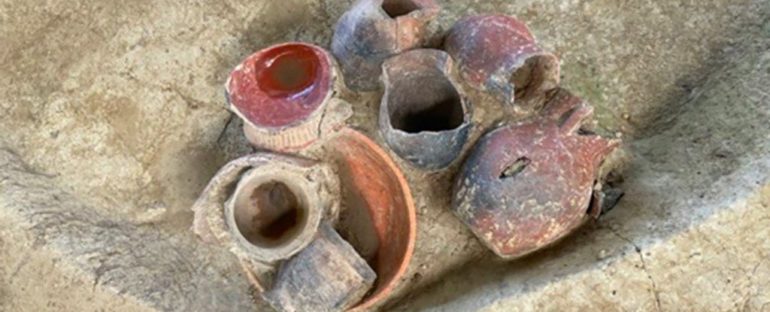Archaeologists have discovered some of the oldest artifacts ever found to be associated with beer, in a haul from Qiaotou in southern China dating back 9,000 years. However, it appears the ancient drinkers in question weren’t in it simply for a buzz.
The find consisted of two human skeletons surrounded by scores of ceramic pots – actually some of the earliest painted pottery ever found – in what appears to be a burial mound in a non-residential area. Of all 50 intact vessels uncovered, the researchers took 20 to analyze.
Previous research has established criteria for identifying socially valued food items in the archaeological record, such as whether the ingredients are hard to collect or take time to produce. The beer in this case would tick most of those boxes, leading archaeologists to conclude the beverages in these containers weren’t just a part of a regular meal.
All that points to the drinking having been part of a ritual ceremony relating to the burial of the dead, the researchers think. Some of the pots were similar in size to the drinking glasses of today, while seven of them appeared to be long-necked Hu pots, used for drinking alcohol in later historical periods.
“Through a residue analysis of pots from Qiaotou, our results revealed that the pottery vessels were used to hold beer, in its most general sense,” says anthropologist Jiajing Wang from Dartmouth College, New Hampshire.
“This ancient beer though would not have been like the IPA that we have today. Instead, it was likely a slightly fermented and sweet beverage, which was probably cloudy in color.”
The analysis of the pots looked at samples of starch, phytoliths (preserved plant residue) and fungi recovered from the inside of the uncovered items, which were then compared with control samples taken from the surrounding soil.
The traces of starch granules, phytoliths, mold and yeast found in the pots were all consistent with the process of beer fermentation. It appears that rice, grain, and unknown tubers were used to cook up the booze. Rice husks and other plant parts may have been added to aid fermentation.
As the remains are from so long ago – back when rice was just beginning to be used as a staple food – it’s difficult for the researchers to say for certain how the alcohol might have been produced by this ancient community.
“We don’t know how people made the mold 9,000 years ago, as fermentation can happen naturally,” says Wang. “If people had some leftover rice and the grains became moldy, they may have noticed that the grains became sweeter and alcoholic with age.”
“While people may not have known the biochemistry associated with grains that became moldy, they probably observed the fermentation process and leveraged it through trial and error.”
Mold acts as an agent in both stages of the beer-making process: saccharification (transforming starch into sugar with enzymes) and fermentation (converting sugar into alcohol and other states with yeasts).
The researchers have also tried to slot the discovery of these beer pots with the wider picture of society in China at the time. Today, this area of southern China is the country’s rice heartland, but then it would have been populated by hunter-gatherers relying on foraging for food.
More advanced rice farming communities wouldn’t form for another several thousand years, and the team behind this new study thinks that beer might have helped oil the wheels of cooperation and society back then, just as it can do today.
“The findings suggest that beer drinking was an essential element in prehistoric funerary rituals in southern China, contributing to the emergence of complex farming societies four millennia later,” write the researchers in their published paper.
The study has been published in PLOS One.



